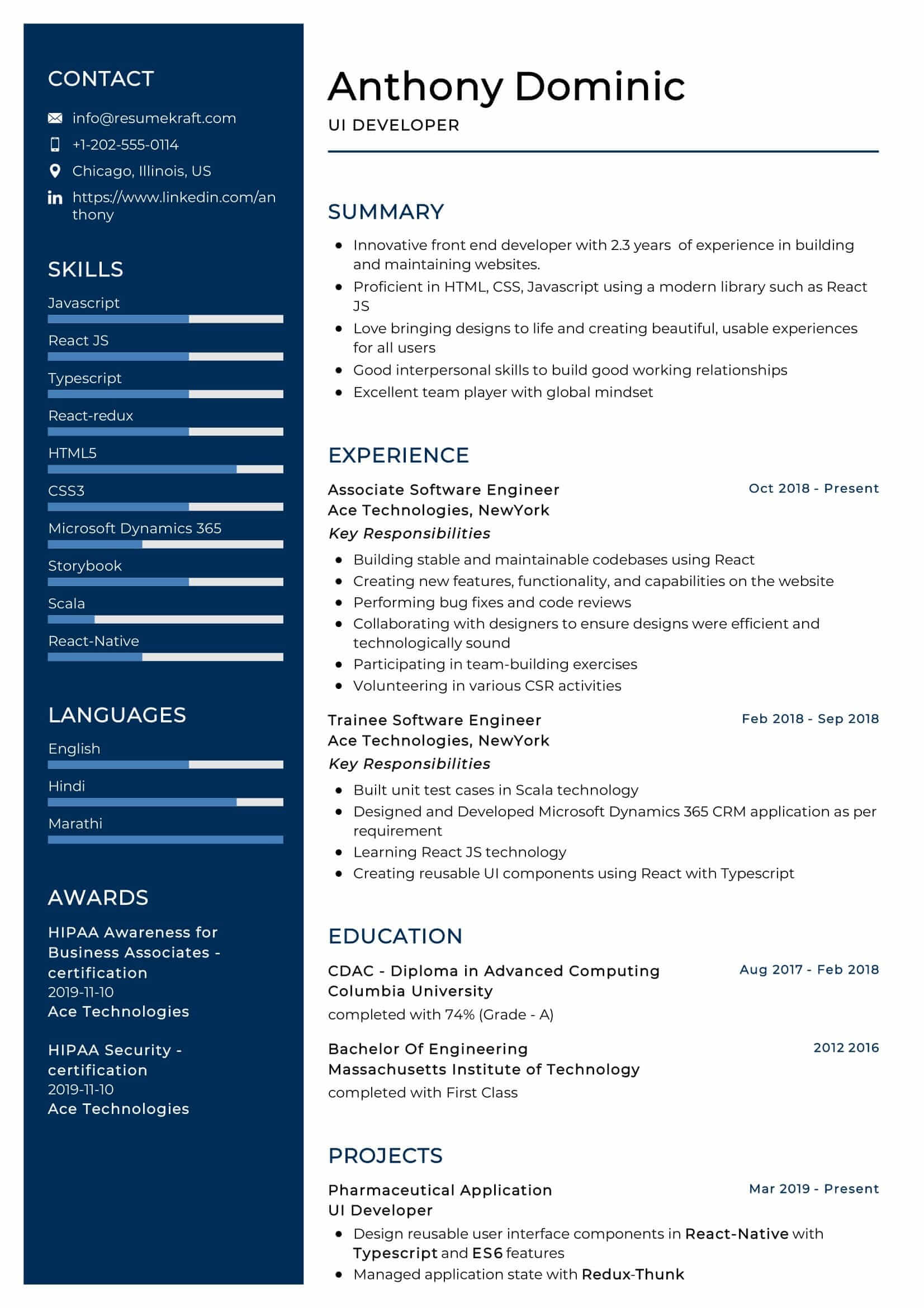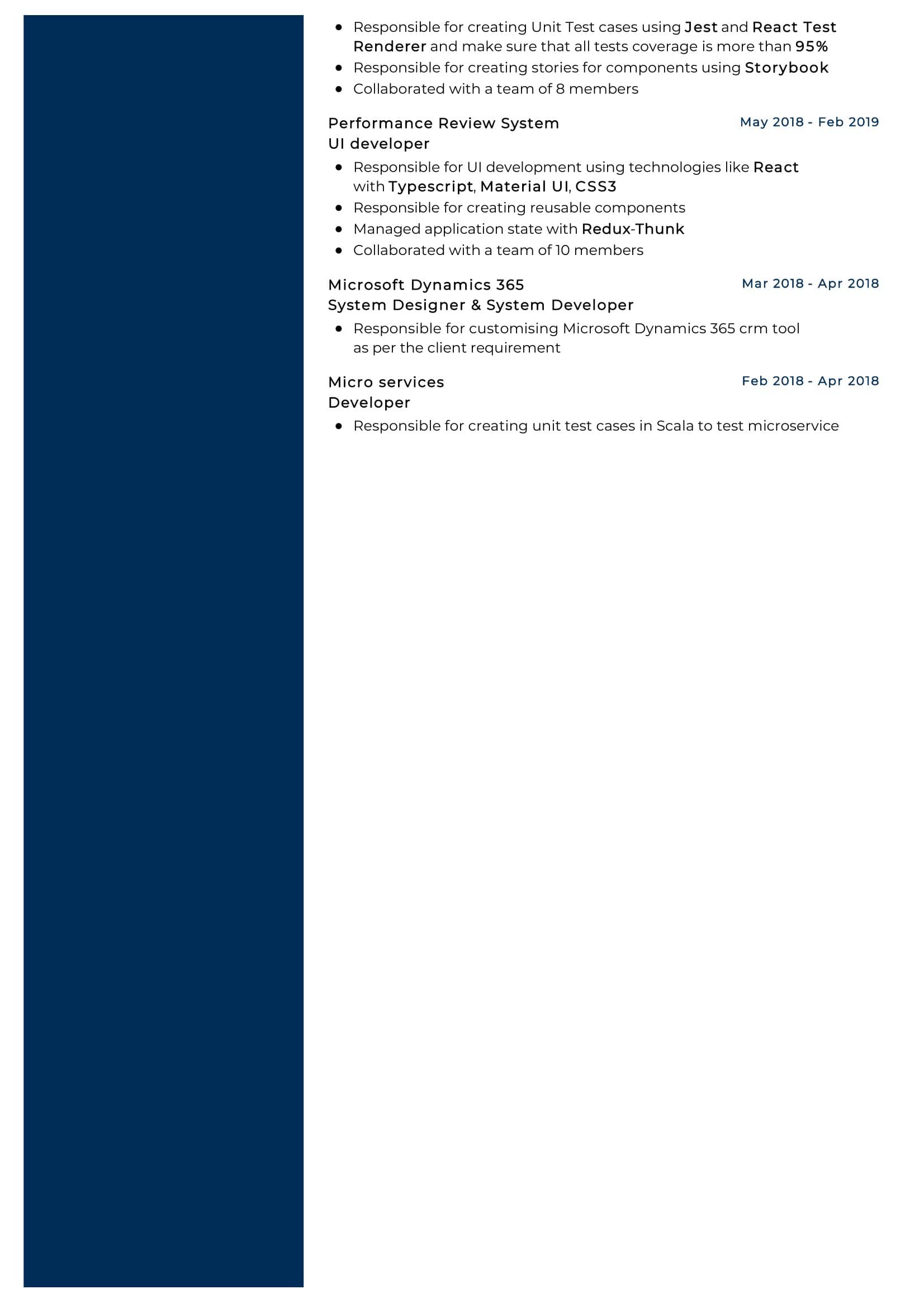UI Developer Resume Sample
Anthony Dominic
UI Developer
Summary
- Innovative front end developer with 4 years of experience in building and maintaining websites.
- Proficient in HTML, CSS, Javascript using a modern library such as React JS
- Love bringing designs to life and creating beautiful, usable experiences for all users
- Good interpersonal skills to build good working relationships
- Excellent team player with a global mindset
Skills
Work Experience
Associate Software Engineer
Ace Technologies, NewYork
Key Responsibilities
- Building stable and maintainable codebases using React
- Creating new features, functionality, and capabilities on the website
- Performing bug fixes and code reviews
- Collaborating with designers to ensure designs were efficient and technologically sound
- Participating in team-building exercises
- Volunteering in various CSR activities
Trainee Software Engineer
Ace Technologies, NewYork
Key Responsibilities
- Built unit test cases in Scala technology
- Designed and Developed Microsoft Dynamics 365 CRM application as per requirement
- Learning React JS technology
- Creating reusable UI components using React with Typescript
Education
CDAC – Diploma in Advanced Computing
Columbia University
Bachelor Of Engineering
Massachusetts Institute of Technology
Projects
Pharmaceutical Application
UI Developer
- Design reusable user interface components in React-Native with Typescript and ES6 features
- Managed application state with Redux–Thunk
- Responsible for creating Unit Test cases using Jest and React Test Renderer and make sure that all tests coverage is more than 95%
- Responsible for creating stories for components using Storybook
- Collaborated with a team of 8 members
Performance Review System
UI developer
- Responsible for UI development using technologies like React
with Typescript, Material UI, CSS3 - Responsible for creating reusable components
- Managed application state with Redux–Thunk
- Collaborated with a team of 10 members
Microsoft Dynamics 365
System Designer & System Developer
Responsible for customizing Microsoft Dynamics 365 CRM tool
as per the client requirement
Microservices
Developer
Responsible for creating unit test cases in Scala to test microservice
Languages
- French
- English
- German
- Chines
UI Developer Resume with Writing Guide
We’re here to help show you how to write the perfect UI Developer resume, with a guide on customizing your resume and tips from industry professionals. We’ll present each part of a UI Developer’s resume, show you what is important to include for each, and give you tips for helping your application stand out. Follow this step-by-step guide for resumes and cover letters tailored just for you!
First things first: there are many different types of resumes. You should choose which kind suits you best.
The resume is a guide to your work history and experience. This is more than just a list of jobs. It’s an opportunity to describe what you have done, why you did those things, and what your specific skills are. It’s a way to talk about each thing that helped you get where you’re at now, in a way that helps the hiring manager understand that you are right for the job opening.
UI Developer Resume Writing Guide:
When writing your resume and cover letter, remember to be concise. Writing too much will make it difficult for the hiring manager to read. This is because you don’t want all of your information competing for attention. The employer will either understand what you are saying, or they won’t.
Make your resume organized, and make it easy for them to find exactly what they’re looking for in a short amount of time.
The resume must stand out. It’s not enough to just say “I’m a good programmer.” You want to show that you’ve accomplished something in your experience. If you have an impressive list of achievements, then you can talk about those instead of repeating them over and over. Most important, take the time to proofread what you write and make sure it looks professional!
There are many different ways to structure your resume but this is the only guide we’ll have on this matter. The resume follows a specific format:
Objective statement/skills summary (procedural skills, languages, tools)
Work history (linked to your objective statement) Education and training (linked to your objective statement if relevant Professional experience (linked to your objective statement) References (You will get these later!) Contact information List of reference letters attached to the end of the resume. This is optional. Optional. This list of references can make you look more professional than other candidates with no references at all.
Keep these columns in mind when you’re writing your resume.
Personal info: Talk about yourself briefly, only long enough to get across the important information. Don’t be boring! Describe yourself and what you like, your personality, and why you are good at programming. Include a little about your hobbies and interests as well (but not too much or it will look like you aren’t focused on the job).
Objective statement: This is one of the most important parts of your resume. This is not about saying “I want a job”, but rather a detailed list of the skills you can bring to the table. Remember, this is a guide about what kind of work you would like to do in the future. Don’t include things about what you did in the past, instead focus on what you can bring to the table in the future. If you can’t demonstrate your skills, then how will they be able to trust that you have the skills for the job?
Work history: Talk about your work history, but briefly. Don’t describe every detail of your day-to-day. Describe the most important things that helped you get where you are now.
Education and training: This section is optional. If you have special educational programs or training, talk about those here. Be careful though! Make sure they are relevant to this job. If they are not, don’t include them!
References: This is optional as well.
UI Developer Responsibilities:
- Working behind the scenes to create and implement user interfaces for web and mobile applications.
- Visually creating highly usable, intuitive graphical interfaces.
- Gathering requirements, creating prototypes, and overseeing usability testing.
- Presenting work to clients or other members of the development team as needed
- Providing technical support at both the user interface level for developers and on an individual basis for users.
- Providing user training for users and developers.
- Debugging and addressing bugs on client sites as needed.
- Providing user support and troubleshooting for clients.
Top 10 Must-have UI Developer Skills:
- Basic knowledge of HTML5, CSS3 and JavaScript
- Familiar with Bootstrap and Material Design
- Good experience in developing and maintaining the web pages with the above-mentioned technologies
- Familiarity with Angular JS for single page applications (SPA)
- Experience in jQuery, Ajax, JSON and XML
- Very good SQL skills – ability to write complex queries and handle large data volumes
- Excellent native-level English language skills – both verbal & written
- Demonstrated ability to work under pressure; ability to complete tasks in a short span of time
- Deep understanding of how to design and develop real-time web applications
- Demonstrated ability to work autonomously, create solutions without direct supervision
Designing apps with Bootstrap is far easier than doing so with other frameworks because there’s a better understanding of how the structure should be. One must strive for simplicity in every aspect of the design so that it can be easily understood by the target audience.
Tips to write a UI Developer Resume Summary:
- Start by writing a strong summary that describes your technical expertise. Previous employers will skip right to your resume summary and make a quick decision on whether or not to read further. Give them a good reason to continue reading!
- Tailor your resume for the position you are applying for. If you have relevant experience, emphasize it! That’s what hiring managers will notice first.
- Use strong language. Hiring managers want to know if you are a team player and will fit the culture of their company. They also want to know that you understand their problems and have concrete suggestions for solutions.
- Use action words in your bullet points to convey enthusiasm, energy, and passion about your work.
UI Developer Resume Summary Example:
“A self-motivated individual who is comfortable working under pressure and can adaptable to change. A detailed evaluator and observer who reads code and designs to solve problems. Experience in Test Driven Development (TDD) with xUnit.net, C#/JavaScript/JQuery with a strong background in Silverlight, HTML5“.
How to write a UI Developer Resume with No experience:
- Use numbers to make your achievements more impressive: Instead of writing “Assisted in the development of new systems”, use something like “Co-developed all new systems, increasing user accessibility by 20%”. Numbers make everything sound impressive, even if it’s not.
- Use words like “specialize” and “expert” to project a professional tone: Instead of writing ” Gained experience in web and mobile applications” write something like “Specialized in web and mobile application development” .
- Use phrases to make your experience sound livelier: Instead of “Worked on a remote, self-managed team” write something like, “Worked on a remote team in a fast-paced environment”.
- Avoid being objective: Whenever you talk about something, assume that the audience knows what you’re talking about. If they don’t, they’ll mess up your sentence anyway and you stand no chance of making yourself sound impressive.
- Avoid grammar mistakes: Copy-paste your resume to make sure all of your sentences are grammatically correct before you submit it. You don’t want to look in top 10 grammar mistakes in resumes and end up looking like a fool.
- If you’re not sure about the information, just don’t write it: Some people think they’re applying for a job and therefore need to fill out every single box with their contact details. If you’re not positive about something, don’t write it down.
How to write a UI Developer Cover Letter:
- Use the Job Posting
When applying for a job, a cover letter is required. Whether you’re applying through an online platform or by sending your résumé and cover letter directly to the hiring manager, it’s important to use the job posting as a reference when writing your cover letter. Take note of specific requirements such as a minimum GPA level or a number of years experience. - Follow a Template
There are several good templates to choose from. The most popular have been compiled by the writer of the UI Developer Resume Companion: The Cover Letter.
A customization guide is available for each template, allowing you to make your experience shine in any way you like. - Make It Relevant
Because your cover letter is not part of the official job posting, make sure it can stand on its own. This means focusing on your skills and accomplishments in a way that shows that you’re not just applying for the position but are capable of succeeding. - Keep It Short
Although it’s best to write at least two pages for a cover letter, keep it short! Any more than 2 pages will give you less attention than your well-written cover letter deserves.
Key Takeaways:
- List each position separately. Show the industry that you have relevant industry experience by listing each position separately, even if you held multiple positions at the same company.
- Highlight your relevant skills and technical knowledge.
- List technology used by listing software or hardware, rather than company names (this section should be a bulleted list).



